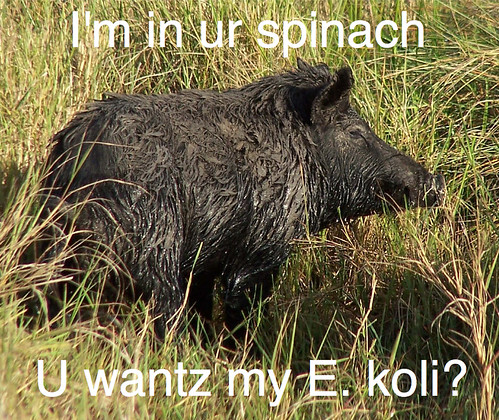
(Yes, it's LOLFeral Pigs)
![]() A recent article in Emerging and Infectious Diseases just made the explanation of the E. coli spinach outbreak much more complex.
A recent article in Emerging and Infectious Diseases just made the explanation of the E. coli spinach outbreak much more complex.
When the contaminated spinach story broke, there were a lot of accusations bandied about that this showed that either corporate factory farming was evil, or that organic farming (the farm was organic) was evil* (an aside: by now, it should be apparent to everyone that politicized public health and biological issues are often not discussed rationally or consistently). I'm no fan of corporate farming because the high densities of animals require antibiotic prophylaxis to prevent disease outbreaks (or government subsidies for failed flocks and herds as is done in Denmark).
But the spinach outbreak might have a far more mundane cause: feral pigs pooping on the spinach fields. To digress a little, the density of feral pigs was 3.8 - 5.9 pigs per square kilometers, and the ranch on which the spinach was grown is estimated to have a total feral pig population of 149 animals. That's lotsa pig.
What the researchers found, using the most detailed genotyping methods other than whole genome sequencing, is that the same E. coli O157:H7 genotype that made people sick was also found in cattle feces and feral pig feces, and was not found in river sediment, cattle pasture soil, or surface water**. It is unclear if the cattle are transferring this strain to pigs, or vice versa. Alternatively, this genotype might stably reside in the feral pig population, or the cattle and pigs might be getting it from some other unknown environmental source.
The authors write:
Recovery of related E. coli O157 subtypes by both methods suggested swine-to-swine transmission, interspecies transmission between cattle and swine, or a common source of exposure such as water or soil...
A relatively high density of feral swine near cattle and spinach fields could represent a risk factor for E. coli O157 contamination. Wildlife may be sentinels for E. coli O157 in the produce production environment, or they may be vectors involved in the contamination of plants directly by fecal deposition or indirectly by fecal contamination of surface waterways or soil. Notably, baby spinach is harvested with a lawn mower-like machine that could pick up fecal deposits in the field and thereby contaminate large volumes of product during processing. Fecal loading of surface waterways by livestock and wildlife with subsequent contamination of wells used for irrigation represents another possible route of transmission to plants in the field....Unrecognized environmental and management practices during preharvest and postharvest processing also could have contributed to amplification and dissemination of E. coli O157 in raw spinach.
In other words, it's not entirely clear how the feral pigs became O157 carriers, but feral pigs might be the proximal cause of the contaminated spinach. Not very exciting--we don't need or want Congressional hearings about the Dangers of Feral Pigs--but it's a good explanation for how this particular case happened.
*The cattle were ranch cattle (i.e., not feedlot raised).
**Cattle and pigs also shared other O157:H7 genotypes, but they also had some unique ones.
- Log in to post comments

I'm showing my true geek colors here...do you mind if I post that macro to LOLScience on Live Journal?
Stacey,
Go ahead (but link back here if possible).
It goes to show you though, there's no 'best way' to raise animals--free range, natural etc. have their risks just like larger scale operations do.
oh good old E. Coli. you just can't get rid of em
Done and Done. Thanks!
It goes to show you though, there's no 'best way' to raise animals--free range, natural etc. have their risks just like larger scale operations do.
Posted by: Aggiemicro | January 21, 2008 11:00 PM
It does seem like that "greener grass," ( no pun intended, LOL), doesn't exist. You don't see the flaws from this side of the fence and once in that greener grass problems become obvious that sometimes make you want to jump the fence back! LOL!
Dave Briggs :~)
Actually, we do very much need Congressional hearings about the Dangers of Feral Pigs. They are a huge problem in more ways than one.
They are invasive and destroy ecosystems and threaten many native species (ex: The Smoky Mountain National Park is fighting to keep feral pigs from destroying fragile Appalachian ecosystems. An international example: feral pigs are causing species declines on the Galapagos and other tropical islands). As carriers of E. coli that's just another reason to speed up efforts to round up and eliminate feral pig populations.
bluejay42,
Fair enough, although I think it would degenerate into another baseball steroids episode of silliness. And then you would have the pro-feral pig supporters....
I remember when the story broke late in 2006 there were several reports linking feral pigs to the outbreak because they found a dead infected pig nearby, and there was evidence that the feral pigs were breaking through the fence surrounding the ranch. So this angle isn't exactly a surprise, but regardless, it is great to see a published scientific study on the subject. Also, I do not think we had LOLPIGS back in 2006 and the story is so much better with LOLPIGS!
Kafamı attırma domuz resmini kaldır
Bebek Oyunları
Araba Oyunları
Barbie Oyunları
Yeni oyunlar
Çocuk Oyunları
Play Free Online Games
Free Online Games
Spielen
Sohbet
Full film izle
film izle
film seyret
Film izlesene
Film izlesene
They are invasive and destroy ecosystems and threaten many native species (ex: The Smoky Mountain National Park is fighting to keep feral pigs from destroying fragile Appalachian ecosystems. An international example: feral pigs are causing species declines on the Galapagos and other tropical islands). As carriers of E. coli that's just another reason to speed up efforts to round up and eliminate feral pig populations